Beating Programmer's RSI
I thought it would never happen to me. I pride myself in a healthy work-life balance, splitting my time between the computer and sports. However, what I thought was overuse from climbing was actually diagnosed as RSI in my wrist from typing. The past weeks have been amongst the most frustrating of my life. My orthopedist ordered 6-8 weeks of rest and a brace for my wrist.
No typing and no climbing? Impossible. I have tried to limit typing as much as possible. But I also spent 6 weeks closely observing my hand movements, researching and experimenting treatments. I didn't find any good resources for RSI treatment for programmers. All I found was the same advice over and over again: improve your ergonomic setups or the pain is in your mind.
*Disclaimer: this is not meant to be medical advice. If you suspect you have any type of hand injury, consult a doctor and get a proper diagnosis before trying any treatments and therapies on your own.
Diagnosis: Tenosynovitis (Sehnenscheidenentzündung)
My orthopedist had a younger doctor shadowing him that day, so he explained thoroughly how the diagnosis worked. He ran his hands in a pinching motion from my wrist to my elbow, comparing both arms. My left arm was firmer because the sheath surrounding the tendon (Sehnenscheiden) was enflamed (Entzündung). In English this condition is called Tenosynovitis.
Although the pain is in my wrist, the swelling is in my forearm. To understand how everything is connected, see this description of the cause of Tenosynovitis from the Mayo Clinic:
Tendons are rope-like structures that attach muscle to bone. When you grip, grasp, clench, pinch or wring anything in your hand, two tendons in your wrist and lower thumb normally glide smoothly through the small tunnel that connects them to the base of the thumb. Repeating a particular motion day after day may irritate the sheath around the two tendons, causing thickening and swelling that restricts their movement.
To summarize my RSI:
- The pain is in my wrist.
- The swelling is in a flexor tendon my forearm.
- And the cause is in the movement of my fingers.
Causes of my RSI
There are many causes for RSI. But I chose to investigate mine further through observation. If programming is the cause, then future flareups are a real possibility. If I can make lifestyle or work changes to prevent that, I'm going to try it.
Be aware that your causes may be very different from mine.
Programming versus typing
The cause of Tenosynovitis in the arm is repetitive movement of the fingers, which doesn't necessarily mean typing. It can, for example come from climbing or playing the violin. In my case, I believe it comes specifically from programming.
After my diagnosis I tried to observe my hand movements closely to find a pattern. In general, my wrist hurts when I work a full day at a computer, even if I am mostly writing emails, doing research, etc. But I noticed the longer lasting pain comes from coding sessions.
So what is it about programming that made my pain worse?
< HTML > and the German keyboard layout
I write lots of HTML, which requires < and >, which on a German keyboard is on the bottom left corner of the German keyboard. I initially wore my sheath while typing on doctor's orders and noticed I had trouble hitting those keys. It was only then I realized how often I used them, and how much of a stretch it is for my fingers.
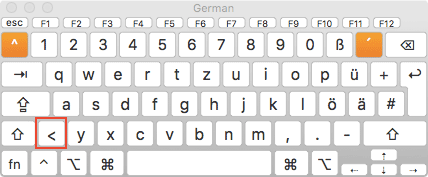
HTML carats are at bottom left corner and most easily reached by pinky finger.
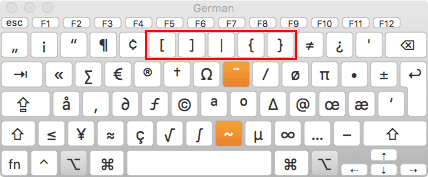
Other common programming characters, including brackets and braces are hidden behind the alt option key.
Keyboard Shortcuts stretch the tendons
But it's not just the German keyboard layout at fault. In general, keyboard shortcuts have been a problem. I tend to not move my wrists, which means that whenever I need cmd, shift, ctrl or worse tab, I contort or stretch my pinky finger to reach those keys.
Remember that my Tenosynovitis is on the outside (not thumb side) of my arm. Basically this means that the fingers on that side of my hand are at fault, specifically my pinky and ring fingers.
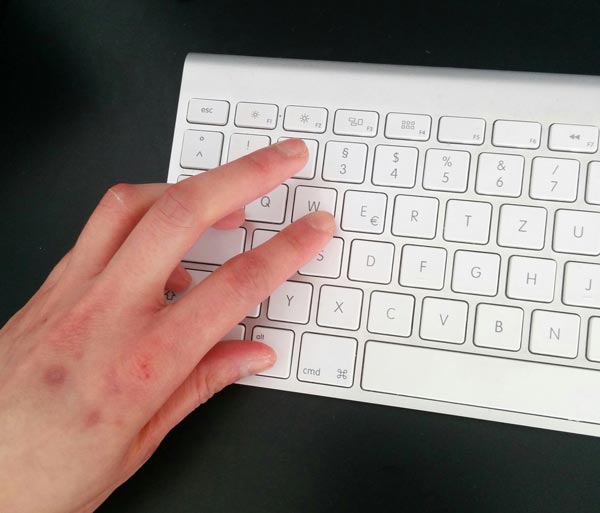
After a week of observation, I decided my pinky was the problem and that the tab key was especially aggravating. Unfortunately the tab key only exists once on the keyboard, so I could not switch fingers.
But eventually I found treatment around this. Read on.
Conventional Treatment: immobilization and rest
Conventional treatment is common sense. There's nothing I can tell you that you won't find on the Internet.
My doctor prescribed 6-8 weeks of rest, which meant immobilizing my wrist as much as possible. The supportive sheath he prescribed allows movement of the fingers so I could type. I did wear this for about 4 weeks, but not when typing. As a programmer, I felt it was too restrictive for typing and I worried that I would develop unnatural movements from it.
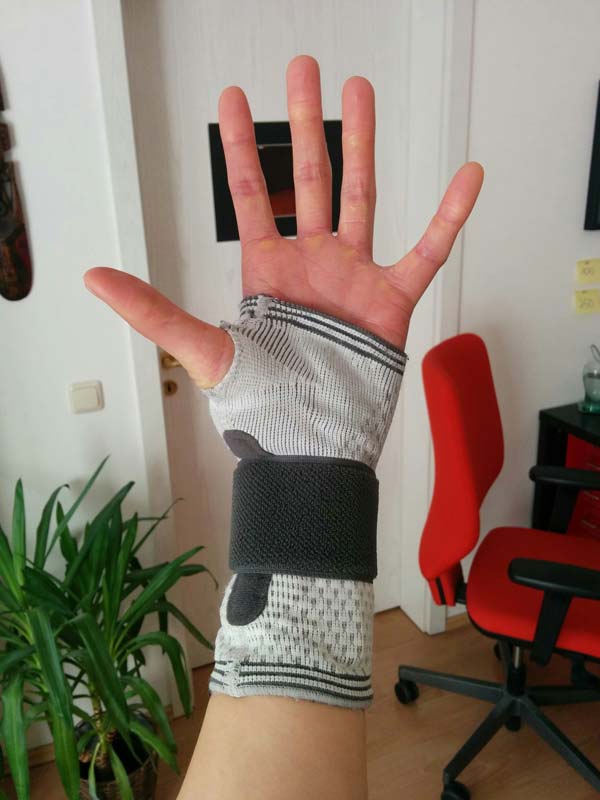
But the brace did help in everyday situations that did hurt my wrist, including:
- putting on a sweatshirt
- instinctively catching a sugar jar that fell out of my cabinet
- grabbing heavy things like my backpack or plate.
After about 4 weeks, my wrist felt like it hurt more from just being weak. And I knew from my climbing that my left wrist was significantly weaker. So I stopped and switched my focus to pain prevention.
Unconventional Treatment Ideas for RSI from Sports Therapy
To repeat, my doctor's advice to rest my rest as much as possible is sensible advice and will work. That much rest just isn't possible for me. I need to work to pay the bills. And I need to climb for my physical and mental health.
Buddy Taping my finger
As described above, I observed that the most problematic movement was my pinky finger reaching over for the tab key. So I taped my pinky finger to my ringer, preventing it from overextending itself. Although weird and irritating at first, I am slowly training my left hand to move more while typing. And it's working. My left hand moves more and I feel less pain.

Flareup Prevention with Eccentric Exercises
Even if you don't have RSI, I highly recommend the Thera-Band FlexBar. My friend Patrick Dubroy got one to help with his RSI. At first, I was skeptical. My doctor had told me there wasn't any strength or preventative exercises I could do for my RSI. But he also did say that RSI can progress and sufferers will developer golfer's elbow type symptoms. And there are other treatments for that: eccentric exercises.
In 2009, the New Yorks Times published on their "Well" Blog Phys Ed: An Easy Fix for Tennis Elbow? that described the success of using Thera-Band FlexBars in a study:
Doctors thought the early results had been too unfair. The control group had showed little or no improvement. But the rubber-bar-using group effectively had been cured. Those patients reported an 81 percent improvement in their elbow pain and a 72 percent improvement in strength.
Granted there were only 21 people in that study. But it has totally worked for me. The FlexBar is effective and different because it as an eccentric exercise, which is described in the same NYT post:
The program involves eccentric exercises, which aren’t oddball moves but those in which the muscle lengthens as it tenses. Think of a biceps curl. When you raise the dumbbell, your bicep shortens and tightens. That’s a concentric contraction. When you lower the weight, the muscle lengthens, straining against the force of the weight. That’s eccentric.
Friends know me as an avid climber, who also consumes literature and magazines about climbing. I have a book called Make or Break - Don't Let Climbing Injuries Dictate Your Success by Scottish climber Dave MacLeod. In the book, he describes his personal experience and frustration with golfer's elbow and his determination to continue climbing. In the end, eccentric exercises solved his elbow pain. The trick was to stick with it, although eccentric exercises may initially worsen the condition. In MacLeod's case, he describes his surprise when a NHS specialist in London told him his mistake was not pushing through the pain in the first weeks of his eccentrics program.
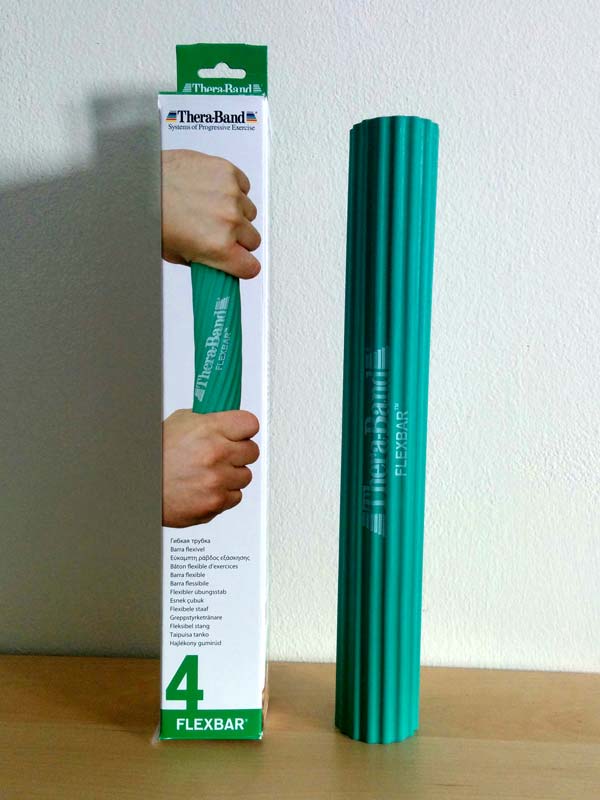
Box shows standard exercise that "strengthens the wrist and finger extensors of the forearm".
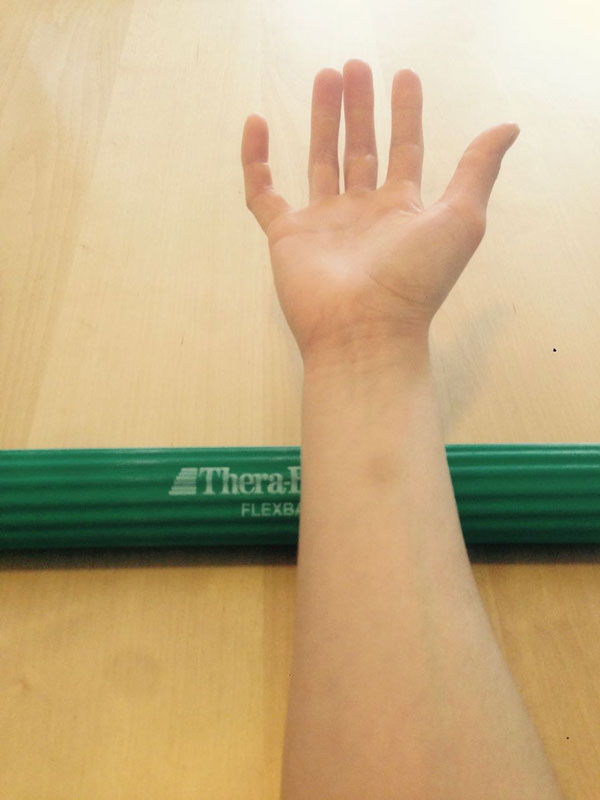
The FlexBar is effective at massaging away any tension in the tendons in the arm.
After I read that, I became more than convinced that eccentric exercises, especially the FlexBar are the answer for me. I do the standard FlexBar exercise at least twice a day, usually 3 sets of 10 repetitions in the morning and before I go to bed.
Massages with the FlexBar
In Mid March I started experiencing tension and sharp pain on the top side of my right arm. It might have been from a tough climbing session. But using a mouse or trackpad aggravated it - a lot. I worked my way through the pain by smearing my arm in Tiger Balm, leaving me smelling like an old Chinese woman. That would not be OK in the office or on site with a client.
I went looking for more eccentric exercises and found out that I could use the FlexBar to give myself a massage. And oh my, it felt so good!
If you've ever received a massage from a physical therapist, you might know that it often hurts and can result in bruises. But you feel so much better the next day. The same happened with my arm massage. My arm felt sore immediately afterwards. But the tension was quickly gone and felt entirely gone by the next morning. Now when I start to feel any tension or knots, I give myself a massage.
Programming and RSI
Google RSI treatment for programmers and you'll find loads about ergonomic keyboards and setups. While important, I found it to be the least impactful for me. I believe strength training and eccentric exercises are key to preventing flareups while as ergonomic devices only minimize symptoms and damage caused by extensive typing.
But I did make the following changes.
Time Out App
Patrick uses an app on his computer that fades out the screen at intervals to remind you to take a break. Most annoying thing ever, I thought. I have since also downloaded Time Out and set my breaks:
- 6 minutes every 58 minutes, used to get up and just get away from the computer
- 15 seconds every 20 minutes, a reminder to take my hands away entirely from the keyboard and stretch.
Patrick was right. It becomes routine and is overall more beneficial than annoying.
Ergonomic Keyboards
I had multiple ongoing client projects when RSI set in. So I had to work through the pain. I tried Patrick's Microsoft Sculpt Ergonomic keyboard. It felt weird and I couldn't transition enough to make deadlines. So I continued to tape my finger and worked through the pain.
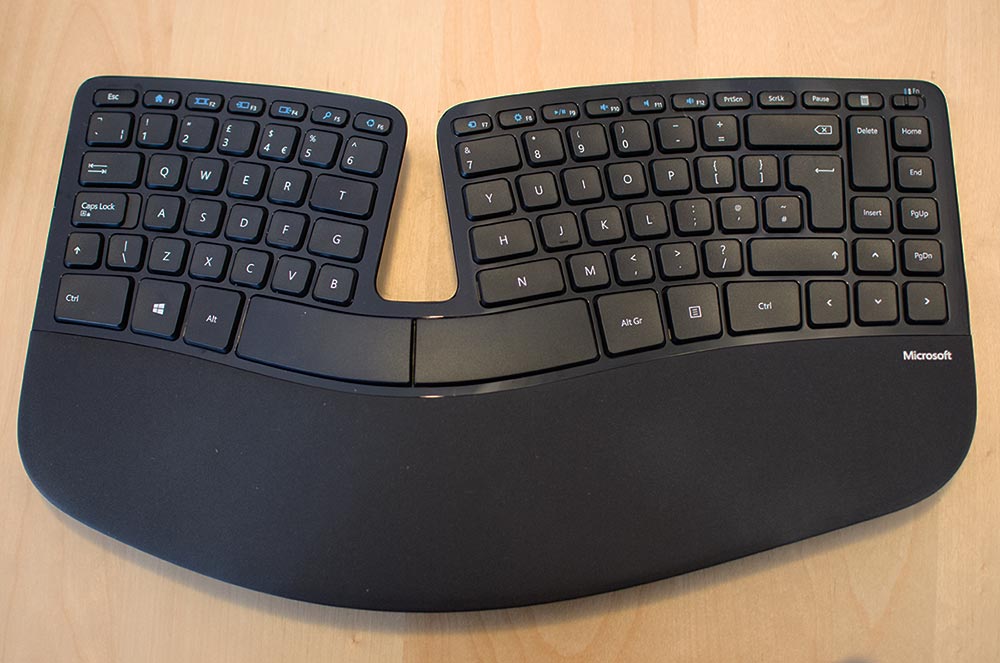
Remember that I also felt that my German keyboard was the problem cause some many programming characters like [ or ), but especially < and > are in weird places and behind key combinations. A German developer told me he switched to the U.S. layout also for RSI reasons. As I finish this blog post, I am typing on a Microsoft Sculpt Keyboard with the UK Layout. It was difficult and expensive to procure a U.S. Layout in Germany so I settled on the UK version for now.
It took about 1-2 weeks to get used to the keyboard. I use the extra stand to tilt the keyboard and it just feels so good. My wrists also seem to move more. But that might be my taped finger talking. The keyboard is louder than an Apple keyboard, but not so much so that it is annoying.

Overall, I would recommend this keyboard to anyone with RSI. To read a detailed review, you should read Marco Arment's review of the Microsoft Sculpt Ergonomic keyboard.
The most challenging part for me will be getting used to not having the German Umlauts (ä ö ü). I often speak and write more German than English on a daily basis. So this is a change. But I am getting used to it. Accessing those vowels is the same on iOS, just push and hold the vowel until a menu pops up with different versions. I am surprised at how muscle memory works. So far, when I have to type on my laptop, it has been ok. I have used the German keyboard for nearly 10 years. But for my next computer, I will probably switch back to the U.S. layout.
Conclusion
If you suspect you have RSI, go to the doctor and have the diagnosis confirmed before you try any treatment on your own. Conventional treatment, esp. resting works.
But I am more interested in preventative treatment. I got an ergonomic keyboard, which I love. But I think what will make the difference long term is strength training through eccentric exercises, that is beneficial not just for preventing my RSI but also improves stability in my arm for climbing.
Although I am not resting my hand 100% per doctor's recommendations, I am not taking risks when climbing either. I know I can only top load my left hand, which means no side pulls or underclings. But overall that has made me a much more creative climber, which has been a surprise gift from my RSI.
So having RSI is frustrating. But it has also taught me loads about my body and I even discovered creativity. Now I just need to channel my patience for 4-6 more weeks, before I can start climbing normally again.
